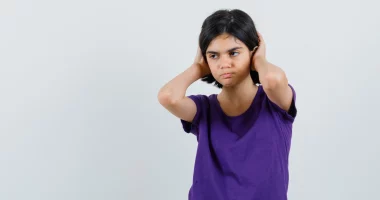Allergic rhinitis, also known as hay fever, is a usual condition that causes signs similar to a cold. These symptoms include sneezing, stuffy nose, sinus pressure, and runny nose.
Allergic rhinitis happens when your body has an allergic reaction to airborne substances like pollen. The period of year you get hay fever depends on which substances you are allergic to.
Despite its identity, allergic rhinitis doesn’t mean that an individual is allergic to hay or that they have a fever. In fact, hay is rarely an allergen, and fever is not one of the symptoms of this condition.
In the United States, Allergic rhinitis is the fifth most common disease.
Symptoms
Symptoms of allergic rhinitis can vary depending on what triggers the allergy and the time of year. For instance, if someone is allergic to pollen, their symptoms might worsen when there’s a lot of pollen in the air.
Allergic rhinitis includes sneezing, often in rapid and repeated sequences, which is a natural response to irritation in the nose. Watery eyes are another common symptom, resulting from the body’s attempt to flush out allergens.
An itchy throat is often reported by individuals with allergic rhinitis. Additionally, the condition can lead to an itchy, blocked, or runny nose, making breathing difficult and causing discomfort.
In more severe cases, symptoms may include:
- Sweating
- Headaches
- Loss of taste and smell
- Facial pain from blocked sinuses
- Itchy sensations spreading from the throat to the ears and nose
Some individuals may also experience tiredness, irritability, and difficulty sleeping (insomnia).
People who have asthma might notice increased wheezing and shortness of breath during times when allergic rhinitis symptoms are prevalent.
Treatment
Treatment for allergic rhinitis involves a variety of over-the-counter (OTC) options, often best used in combination. Consulting a physician is advisable to determine the most suitable approach.
Medication options include antihistamine tablets or sprays, which can effectively manage symptoms like a runny nose and itching but do not alleviate congested sinuses. Older antihistamines may lead to drowsiness.
Eye drops, containing substances like cromoglycate, reduce swelling and itching in the eyes and are typically used along with other medicines.
Nasal corticosteroids, such as fluticasone (Flonase), treat allergic rhinitis inflammation effectively with long-term safety. However, they may cause temporary side effects like an unpleasant taste, smell, or nose irritation.
Oral corticosteroids like prednisone are reserved for severe symptoms and are for short-term use due to potential long-term side effects like muscle weakness, cataracts, and osteoporosis.
Immunotherapy offers long-term relief by desensitizing the immune response to allergens. It can be administered through injections or sublingual drops, the latter of which can be taken at home. Immunotherapy may lead to lasting symptom remission and can help prevent asthma and other allergies.
Alternative therapies
Alternative therapies for allergic rhinitis, such as acupuncture, have been explored, but studies have not conclusively shown significant improvements in symptoms. As with any treatment, it’s essential to discuss the options with a healthcare provider.
While some may consider herbal remedies, none are currently recommended for allergic rhinitis treatment. It’s important to rely on scientifically proven methods for managing symptoms.
For pregnant individuals, consulting a doctor before using any medication is crucial to avoid adverse effects on fetal growth. This precaution ensures that any treatment is safe for both the individual and the baby.
Diagnosis
Diagnosing allergic rhinitis involves a doctor examining the symptoms and asking about the person’s medical history and their family’s medical history. They might also do some tests to figure out what the person is allergic to.
One test is a skin test. In this test, the doctor puts a tiny amount of a known allergen on the person’s skin, usually by pricking it. If the person is allergic to that substance, their skin will react.
Another test is a blood test. This test measures the level of IgE antibodies in the blood. If the level is high, it means the person has an allergy. The blood will result in 20 minutes.
The IgE antibody levels are scored from zero to 6. Zero means no sensitivity, while 6 means very high sensitivity.
There’s also a different kind of skin test where the doctor injects a small quantity of allergen under the skin. They check for a reaction around 20 minutes later to see if the person is allergic to that substance.
Causes
Allergic rhinitis happens when the immune system accidentally thinks something harmless in the air, like pollen or spores, is dangerous. The immune system makes a special antibody called immunoglobulin E (IgE) to fight off this perceived threat. This triggers the release of a chemical called histamine, which causes the symptoms of allergic rhinitis.
Seasonal triggers for allergic rhinitis include things like spores and pollen that are only around at certain periods of the year. For example, tree pollen is common in the spring, grass pollen in late summer and spring, and weed pollen in the fall. Mold spores and fungi are more common in warm weather.
Other triggers for allergic rhinitis can include things like pet hair or dander, mold, cockroach dust, and dust mites. Irritants like perfumes, cigarette smoke, and diesel exhaust fumes can also lead to allergic rhinitis symptoms.
Risk Factors
Certain things can make someone more likely to develop allergic rhinitis:
- Genetics: If someone in your family has allergic rhinitis or another allergy, you might be more likely to get it too.
- Having asthma or other allergies: If you already have asthma or allergies, you’re more likely to develop allergic rhinitis.
- Gender and age: Boys are more likely to have allergic rhinitis before adolescence, but after that, girls are more affected.
- Birth date: Being born in high pollen season may increase your chance of getting allergic rhinitis.
- Exposure to second-hand smoke: Breathing in cigarette smoke when you’re young can raise your chances of getting allergic rhinitis.
Other factors that might increase the risk include being the firstborn can cause allergic rhinitis. These factors could be related to childhood infections.
Having fewer childhood infections might increase the chance of autoimmune problems at another time in life.
Outlook
Allergic rhinitis doesn’t have a cure right now, but there are ways to manage the symptoms, especially when pollen levels are high.
Starting treatment about three months before the pollen season begins can help make it more effective in the first year. Continuing treatment over time can reduce signs, boost immunity to allergens, and make life better. Studies show that three years of treatment can even make you less sensitive to pollen in the long run.
However, if your symptoms don’t get much better after the first year of treatment, it might not be worth continuing.
If allergic rhinitis isn’t managed well, it can lead to more serious problems like allergic asthma, which affects the lungs. People with allergic rhinitis might also be more likely to grow other allergies, like a lack of food tolerance.
Severe allergic rhinitis can also make the inside of your nose more tender to things like dry air or cigarette smoke, which could lead to sinus problems.








